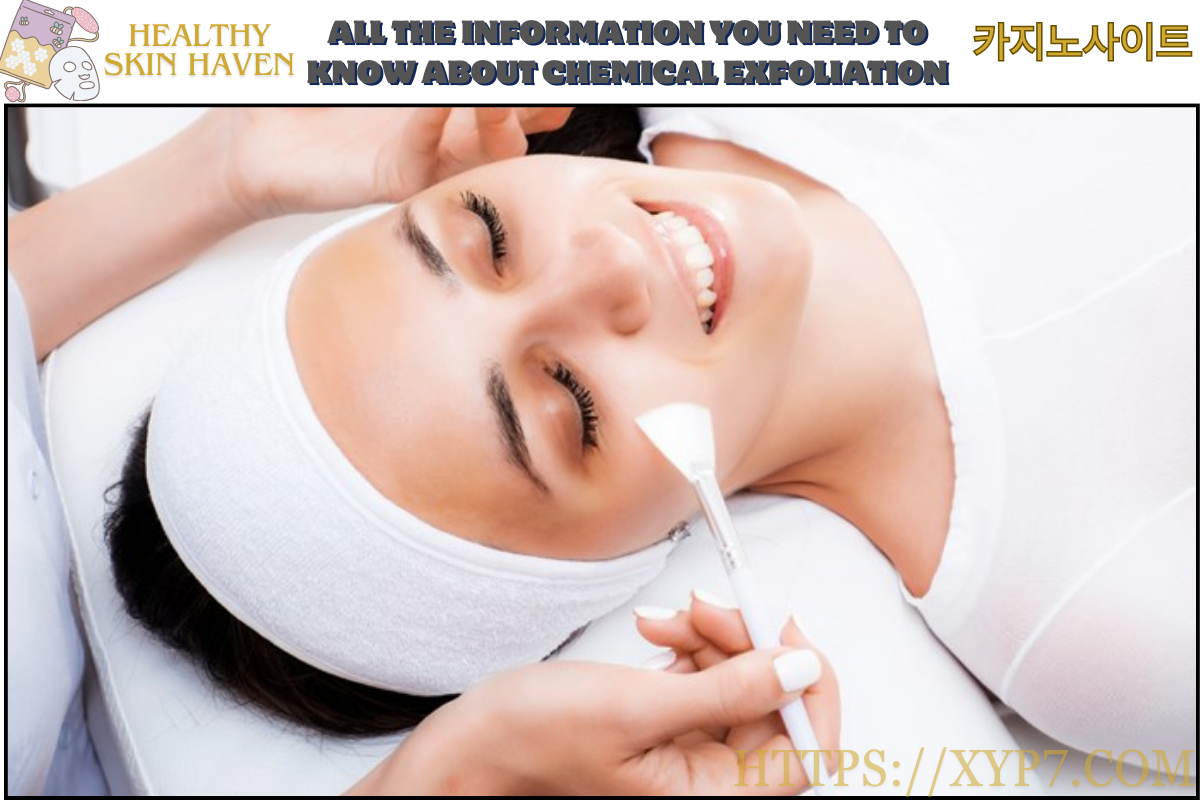All the Information You Need to Know About Chemical Exfoliation. Normally, skin cells regenerate approximately once per month. However, aging and sun exposure can impede this process.
This is the usefulness of exfoliation. It can lighten acne scars and brighten your complexion and is a quick method of getting rid of dead skin.
There are two kinds of exfoliation: chemical and physical. The chemical variety, which consists of several distinct acids, has grown in popularity recently.
However, there’s still some disagreement about what it is and which acids work best. What you should know is as follows.
RELATED: Why Is It Beneficial to Exfoliate After Waxing?

What is a chemical exfoliant, exactly?
Acids found in chemical exfoliants help remove dead skin cells. They exist in different concentrations.
A dermatologist typically administers stronger formulas as a chemical peel, while weaker ones are available over the counter.
In order for them to function, skin cells must be broken off their bonds, according to board-certified plastic surgeon Dr. Michelle Lee.
She said, “The top layers of skin cells shed, revealing regenerated skin, as those bonds are broken.”
Regular use unclogs pores, leaves skin feeling smoother and more even-toned, and may make aging signs less noticeable.
What distinguishes them from actual exfoliants?
Physical exfoliants manually remove the outer layers of skin, while acids do so chemically.
Physical exfoliation, in the form of scrubs, brushes, and procedures like dermabrasion, can be too abrasive for some people.
It might not be as effective because it doesn’t penetrate as deeply as the chemical version.
Are there different kinds?
Chemical exfoliants come in three primary categories. While all acids are the same, some are milder and less corrosive than others.
Acids alpha hydroxy (AHAs)
Glycolic, lactic, citric, and malic acids are examples of AHAs. Although they are often derived from fruits, they can also be made artificially.
Dermatologist Dr. Hadley King observes that because they dissolve in water, they improve the texture of the skin’s surface.
Commonly utilized AHAs in skin care products are lactic and glycolic acids (Trusted Source). For maximum efficacy, choose a concentration of 5–10 percent.
Beta hydroxy acids (BHAs)
According to King, BHAs can act on the surface of the skin as well as penetrate your pores because they are oil-soluble.
These deeper-acting acids clear clogged pores and eliminate sebum that contributes to acne in addition to improving skin texture.
Salicylic acid and tropic acid are two types of BHAs.
Polyhydroxy acids (PHAs)
PHAs and AHAs function similarly. According to King, the reason PHA molecules cannot pierce as deeply is because they are larger.
Because of this, people find them to be less irritating than other chemical exfoliants, especially AHAs.
Additionally, PHAs like gluconolactone and lactobionic acid have additional hydrating and antioxidant benefits, despite not going as deep.
How do you choose the appropriate type?
AHAs are frequently used to lighten moderately discolored areas of skin and skin tone.
However, because of their ability to unclog pores, BHAs are great for oily or acne-prone skin.
If your skin is extremely sensitive, you might want to consider using a less invasive PHA exfoliant.
After two months, are you still not seeing results? Change to an alternative chemical.
If your skin is sensitive or dry
BHAs are great for people with sensitive skin types or redness in their skin because they can calm and soothe the skin.
For sensitive types, however, Zelens’ Bio-Peel Resurfacing Facial Pads with PHAs are also an option. Research has even shown that PHAs can help those who have rosacea and eczema.
Use an AHA if your skin is dry. They will aid the skin in holding onto moisture because they only affect the skin’s surface. The Lactic Acid from The Ordinary receives great reviews.
If your skin is oily or prone to acne
BHAs are excellent at ridding pores of all the materials that can cause breakouts, especially salicylic acid.
For oily skin, thinner liquid formulas work best; Paula’s Choice Skin Perfecting 2% BHA Exfoliant is one such product.
Purchase the Skin Perfecting 2% BHA Exfoliant from Paula’s Choice online.
King says, “Using salicylic acid may have the drawback of making the skin feel drier.”
She suggests using it in conjunction with the AHA lactic acid to “improve the skin’s natural moisture factor.”
If your skin is a combination
Combination skin calls for the best features from each world. Choose a salicylic acid-containing serum for its exfoliating and anti-inflammatory properties.
The lightweight gel texture of Caudalie’s Vinopure Skin Perfecting Serum prevents pore clogging and dry skin.
If your skin is older
AHAs work on deeper wrinkles and fine lines to help reduce the appearance of aging. Additionally, they can smooth rough skin, leaving it radiant.
Along with hydroxy acids, Dr. Dennis Gross Skincare’s Alpha Beta Daily Peel is packed with antioxidants that fight aging.
If you are scarred or have hyperpigmentation
Use a potent AHA formula or a BHA, such as salicylic acid, which can promote skin cell turnover, to lessen the visibility of dark marks and scars.
Alpha-H’s Liquid Gold, which contains 5% glycolic acid, is intended to improve skin hydration and pigmentation.
If there are indications of sun damage
According to King, AHAs have been shown to be useful in lessening the appearance of sun damage.
The combination of glycolic and lactic acids, she says, “resurface uneven texture and reduce surface pigmentation while supporting natural cell turnover.” She suggests using this combination.
The Acid Fix by Omorovicza has both.
If you have a history of ingrown hairs
Salicylic acid, a BHA, and lactic acid, an AHA, can both aid in preventing those bothersome ingrown hairs.
By eliminating dead skin, smoothing out the texture of the skin, and physically raising ingrown hairs above the surface, they achieve this.
For even more calming effects, try the Malin+Goetz Ingrown Hair Cream 카지노사이트.
